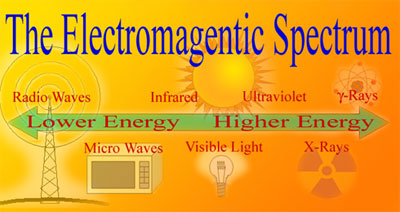Last Revised: October 28, 2021
The term "Non-Ionizing Radiation" refers to those electromagnetic radiations are not energetic enough to cause ionizations in matter. Included in this category are Radio Waves, Microwaves, and low frequency Magnetic & Electric Fields. Please note that laser safety is discussed separately under the "Laser Safety" heading of the EHRS Website.
What is Ionizing Radiation?
Ionizing Radiation is radiation that has enough energy to cause electrons to be knocked out of their orbital shells in an atom, or to break chemical bonds within a molecule.
What is Non-Ionizing Radiation?

Non-Ionizing Radiation is relatively low-energy radiation that does not have enough energy to ionize atoms or molecules.
What are examples of Non-Ionizing Radiation?
This picture illustrates the range of energies in the electromagnetic radiation spectrum. Some very sensitive atoms can be ionized with relatively low energy visible light. However, when one speaks on Ionizing Radiation, one is typically referring to X-Rays or Gamma-Rays. By the same token, the term non-ionizing radiation will usually refer to Radio waves and Microwaves.
What are the health effects of exposure to Non-Ionizing Radiation?
Non-Ionizing Radiation has been the subject of extensive research over the past decades. There is currently no conclusive evidence to confirm a causative link between exposure to Non-Ionizing Radiation and cancer induction. Professional organizations and government agencies continue to monitor progress in research to ensure that current standards and limits on exposure to non-ionizing radiation are sufficient to protect workers and the public.
What if I am concerned about my exposure to Non-Ionizing Radiation at the University or one of its affiliates?
You may contact EHRS at (215) 898-7187 if you have any concerns about Non-Ionizing Radiation.
Additional Information
The following links are provided to help you learn more about Non-Ionizing Radiation issues. If you have any concerns regarding non-ionizing radiation, please contact EHRS for consultation.

Cell Phones and 5G Technology from the Health Physics Society (HPS)
Cell Phone Safety information from the Food and Drug Administration

Radiofrequency Safety information from the Federal Communications Commission.

Radio waves are also emitted by WiFi routers, computers, printers, and other devices to allow wireless connection to the internet and computer networks. These devices operate within the frequency range of cell phone systems, but with much less power output than your cell phone. Additional information is available from the Public Health England.
![]()
Microwave Oven Safety information from the Food & Drug Administration
